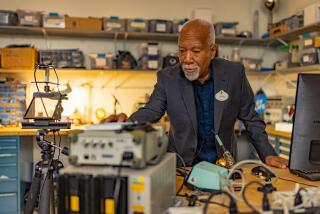Inventor Seeks Next Big Wave
- Share via
Tom Morey is a dreamer, a tinkerer, an idea man. Some of his lesser-known inventions fill his Capistrano Beach garage: a four-winged prototype aircraft made of Jell-O boxes that harnesses the power of compressed air. Various experimental material coatings, including a hunk of foam dipped in liquid rubber and coated with Mop ‘n’ Glow. An idea for an athletic shoe that utilizes interchangeable soles, which Morey believes could eliminate the need for a closet full of footwear.
“I can look at everything and see how to improve it,” says Morey, 68.
His eyes dart across the room and fix on an object to prove his point. “Waste baskets should be made of Teflon,” he declares. “They’d be so easy to clean that way.”
Upstairs, Morey’s most profitable idea hangs on a wall: the first Boogie Board, a slowly deteriorating slab of foam that Morey made in 1971 with an electric carving knife and clothing iron while living as a beach bum in Hawaii. A few weeks later, he made another and sold it to a guy on the beach.
“He handed me 10 bucks and I gave him this piece of foam. And I thought, ‘I like that.’ ”
He was 37. He placed an ad in a surfing magazine and the orders began trickling in. At first, he made each board to order. But soon, Morey had a tsunami on his hands. In his fourth year, he filled 80,000 orders.
Morey’s idea changed the world -- or at least beach activities. He single-handedly created bodyboarding, and became the Henry Ford of surfing, opening the sport to the masses.
It’s an idea that should have made Morey wealthy. But it didn’t. He sold his invention -- and the use of his name -- to a San Francisco corporation in 1978 for an amount he won’t disclose. But one look around his sparsely furnished home suggests it wasn’t the pot of gold you might imagine.
The Wham-O toy company -- which now owns the rights to the name and for whom Morey once worked as a consultant -- sold 250,000 Boogie Boards last year, 65% of the domestic bodyboard market. Meanwhile, Morey gives surfing and drum lessons and builds lightweight surfboards in his garage. He hopes his latest design, the Swizzle, will allow him to catch lightning in a bottle a second time.
And when he says he has not an ounce of regret that his invention didn’t make him insanely rich, you want to believe him, want to believe that it’s the discovery that matters.
“You’re here to learn how to die,” says Morey, who is tanned and trim and very much resembles a maniacal Dennis Hopper when he smiles. “You can’t hold on to all this stuff. You’ve got to let it go. The girl you wanted and you didn’t get. The fortune you almost had. The fish that got away.... Say I had sold this for a billion dollars? I’m still going to be sitting here in my bathing suit. I’m not going to eat any more than I’m eating.”
Morey’s life has been anything but a straight line. He was born in Detroit and raised in Laguna Beach. He started as a music major at USC and ended up with a math degree. He raised six children and has worked as an engineer for Douglas Aircraft and the Boeing Co. He also lived for a while in a van.
This year, Morey was inducted into Huntington Beach’s Surfing Walk of Fame for his contributions to the sport, which go beyond the Boogie Board. In the early 1960s, he invented the first interchangeable fin system for surfboards and pioneered other design innovations. While operating a board-making business in Ventura, he ponied up $1,500 in 1965 for what’s considered to be the first pro surfing competition.
But now that the laid-back surfing culture of the ‘60s has been transformed into the 21st century culture of big-money extreme sports, perhaps Morey’s most enduring contribution is the way he continues to reflect surfing’s carefree, slightly loopy past.
Several years ago, Morey began telling people he changed his name to the letter Y. He no longer needs more, he told them. So, Y not?
There is the left brain and the right brain. Then there is Tom Morey’s brain. It works fast, surging in waves powered by some logic known only to him. In a half-hour he segues from the limitations of symmetrical design to whether gravity really exists to how “The Three Little Pigs” is a metaphor for self-centeredness to the possibilities of perpetual motion to how plastic grocery bags clean teeth better than dental floss....
“I’m simply a guy with a window on a train of life, and maybe the guys next to me don’t have a window,” he says. “I can look out and see the future of things. And then I can tell the world about it. Or build it.”
Edison had his lightbulb, Bell the telephone. The Boogie Board will always belong to Morey, no matter what the lawyers say.
“I found out by doing this that it is possible for one human being to make a tremendous impact on the planet,” Morey says. “In college, I had notions of becoming a doctor, a psychiatrist, an engineer. And by inventing this, I have been all those things. The preventive cures that have resulted from billions of hours of people in the water, in the sunlight -- the exercise, the therapy. Freud couldn’t have done that much.”
More to Read
Inside the business of entertainment
The Wide Shot brings you news, analysis and insights on everything from streaming wars to production — and what it all means for the future.
You may occasionally receive promotional content from the Los Angeles Times.










